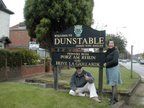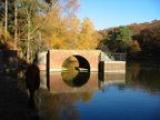Dunstable, UK
Dunstable, MA has a "sister town" relationship to the town of Dunstable in Bedfordshire, England.
Unlike Dunstable, MA, they have a pub!
Some residents of Dunstable, MA (the Reardons) visited Dunstable, UK when they were in England visiting their son.


(The following information was provided by a resident of Dunstable, UK who visited our website.)
Dunstable, UK has 33,000 residents and is still growing. They are supposed to get around 46,000 new homes in the area, which at the least will bring around 90,000 new people into the area, along with all of the cars for them as well. Similar to Dunstable, MA, the current residents would prefer to limit the growth, even though there is a housing shortage in the area, as is the case for all of England. The upper levels of government are driving the creation of the new housing. Dunstable, UK does not have the room or the infrastructure for this policy to work as we are surrounded by Greenbelt land, which was allocated to stop the persistent sprawl of London covering the entire South East of the United Kingdom.
Click here for the Dunstable Town Council's website.
If you're planning to visit Dunstable, UK, you may want to attend one of the local football (a.k.a. soccer) matches to watch the Dunstable Town Football Club team in action. Look for the schedule on their website.
You can get books about Dunstable from Amazon.co.uk. One book that is recommended by a Dunstable, UK history buff is Bedfordshire by Simon Houfe, published by Pimlico.
Scenes Around Dunstable
The following photo of a scene in Stockgrove County Park (near Dunstable, UK) were provided by a resident of Dunstable, UK. The first picture s hows what remains of a little Boat House, built in the '30's and demolished in the war. (The bridge is similar to our own arch bridge.) The whole of this country park used to belong to a King in the 1100's, but now most of it has been set aside as National Trust land to protect its beauty and acres of forests and lakes.
hows what remains of a little Boat House, built in the '30's and demolished in the war. (The bridge is similar to our own arch bridge.) The whole of this country park used to belong to a King in the 1100's, but now most of it has been set aside as National Trust land to protect its beauty and acres of forests and lakes.
History of Dunstable, UK
Prehistoric burial mounds and earthworks on the chalk hills around our town bear witness to its importance since earliest times. The town sits in a gap through the Chiltern Hills on the site of a small Roman settlement called Durocobrivis, which was established at crossroads formed by the Roman Watling Street and the prehistoric Icknield Way.
The site was abandoned in Saxon times but it was here that Henry I founded an Augustinian priory in 1131, built a palace and established a new market town. The town became a place of considerable importance, hosting regular royal visits and jousting tournaments. It was at the priory, in the 16th century, that the annulment of Henry VIII's marriage to Catherine of Aragon was pronounced, followed by the dissolution of the priory itself soon afterwards. Parts of the original priory church, with its fine Norman nave and magnificent west front, survives as the town's parish church.
Dunstable picked itself up from the ruins of the Reformation and again became a busy town with the advent of stagecoach travel. Several coaching inns remain from this prosperous period, which itself declined with the coming of the railway age and the consequent shift of the straw plait and hat making industries from Dunstable to Luton with its main line railway station.
Once again, Dunstable rode out its misfortunes and, at the turn of the century, began to welcome new industries including printing and engineering and, most notably, the motor trade. Today, many companies with household names have premises on the town's modern industrial estates.

